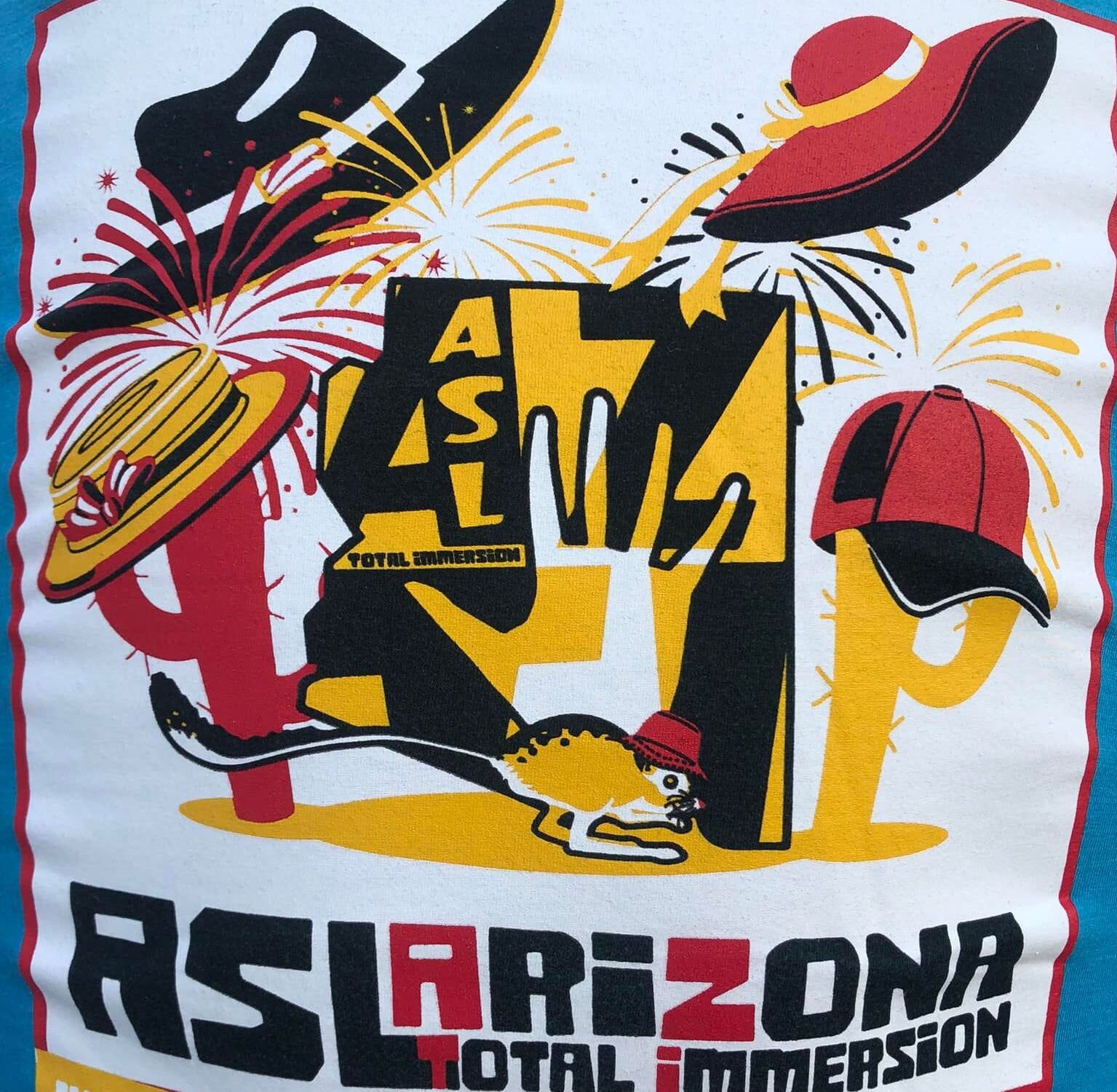Changemaker Catalyst Award recipient, Paola Foresti Pinto, traveled to Phoenix, AZ for the 2022 ASL Arizona Total Immersion retreat, where she plunged into the world of Deaf culture and American Sign Language. Paola Foresti Pinto is rising senior, Class of 2023, majoring in psychology with a minor in SISE.
As a participant in this year’s ASL AZTI retreat, I came in with the goal of improving my signing, meeting new people and gaining more insight into the career of interpreting. However, It was not just about learning ASL. I left with so much more than I imagined I would, such as invaluable connections, confidence, and understanding of Deaf culture and the obstacles Deaf people face in America.
ASL AZTI adheres to the philosophy that native signers are the most equipped to instruct ASL students concerning their language and culture.
The entire program is based on providing an immersive experience, so throughout the five days, there is absolutely no talking or voicing allowed– participants must communicate by signing, writing back and forth, gesturing, texting, or whatever else you need to do, just no talking! Every day, around 30 students woke up for breakfast at 8a.m, and then attended 2-3 classes until lunchtime. After lunch, we attended 2-3 more classes, which sometimes also featured guest speakers or group activities. Finally, after dinner, we played games and trivia until the late hours of the night. Furthermore, classes were divided by levels of signing, and I was in the first level. The program stresses that it is open to all levels of singing, and truly reflected that. There were people of multiple ages present, with various levels of signing skills as well as differing motivations for attending the retreat. Some had Deaf kids or spouses, some were aspiring interpreters, some were becoming Deaf themselves, and some had been attending ASL AZTI for years. Throughout the five days, I attended classes on ASL numbers, vocabulary, grammar, poetry, and a “Sex, Drugs and Alcohol” workshop.

The most wonderful part, however, had to be the staff. The diverse group of ASL AZTI directors and instructors is extremely kind, patient, supportive and playful! They made each one of us feel like we belonged, regardless of signing ability, and shared their impressive signing skills and stories with us. The staff has a multitude of backgrounds. Some were born Deaf, some became Deaf later in life, and some are hearing. However, the majority of instructors were Deaf in order to maintain the authenticity of the program. Moreover, some were born into generationally Deaf families, and used ASL since birth, while others went to oral schools (schools with the goal teaching Deaf children to speak and lip read) for most of their life. Many of them work as ASL instructors at local universities, but also have had careers in interpreting, other areas of education, theatre, Deaf advocacy, basketball and healthcare.

Perhaps the most memorable activity for me was “It’s a Deaf Deaf World”. Us students were led into a room with no prior explanation or debriefing of what was awaiting us. As we shuffled in, various tables were lining the walls of the room. They were labeled: DMV, travel agency, doctor, coffee shop, vet, ice cream shop, public library, bank. Our purpose, we were then told, was to collect as many points as possible (but with no indication of how to successfully do so). Awkward and lost, we spread towards the booths. Once I approached the DMV table, I quickly figured out that communication was difficult at all booths. Staff at each table were using a different method of communication, such as ASL signing, Pidgin Signed English (PSE), Signed Exact English (SEE), The Rochester Method (fingerspelling only), lip reading, writing, Protactile ASL and gesturing. At the coffee shop table, for example, my peer and I teamed up to use Protactile ASL with the “cashier”, who was supposed to be Deafblind. We signed normally into his hand and he interpreted what we were signing, and then wrote back to us on paper. In the post-discussion, many participants, myself included, expressed how frustrating it was at first. Most of us resulted to watching others interact with “establishment owners” and trying to figure out what worked and what didn’t. The purpose of this activity was to simulate how it feels to be Deaf in a hearing world, and the many challenges Deaf people face everyday. The staff’s purposeful lack of will and patience to adapt to our communication methods at the tables made it difficult to try and accomplish the simplest everyday tasks. It also demonstrated how Deafness isn’t a monolith, and there are a multitude of ways Deaf people communicate.


No doubt, the most challenging part of the program was singing all day. Surprisingly, I didn’t struggle as much with successfully communicating, but was always visually fatigued by the end of the day. If you think about it, languages such as English are verbal, meaning that most of the input we receive is auditory, with maybe some visual input by looking at people’s lips. ASL, on the other hand, is a completely visual language, and my brain isn’t used to processing that much visual information all day!
I am extremely proud and grateful to have participated in ASL AZTI. The immersive concept definitely worked– at first, me and my roommate had to mostly communicate by texting or writing. However, by the last day, we were having elaborate conversations all day in ASL. By the end, I felt a lot more confident in my signing, informed about Deaf culture and able to respectfully navigate Deaf spaces. Moreover, seeing interpreters at work, as well as meeting people studying to become interpreters, furthered my passion for pursuing the career. Language access is so crucial, and due to oppression against Deaf communities, Deaf people’s rights to healthcare, education and simple access are denied everyday.
The experience left me with one burning question: when can I register for next year?
